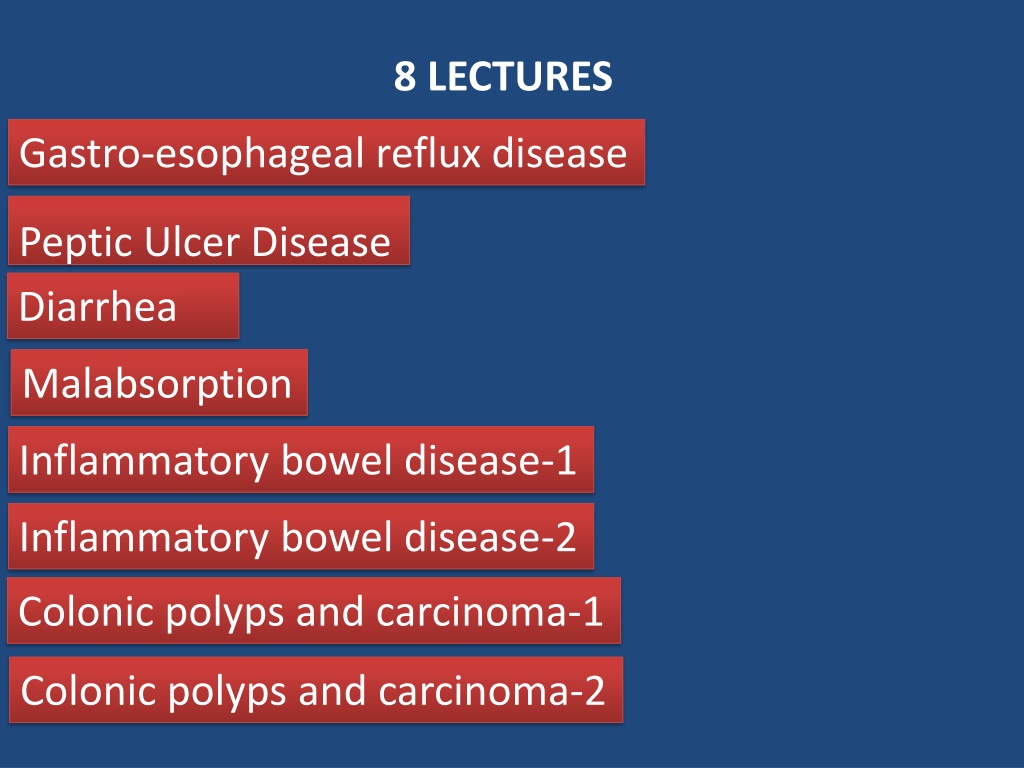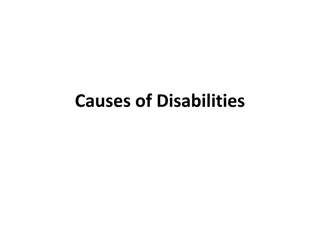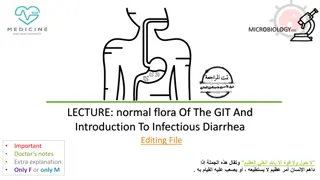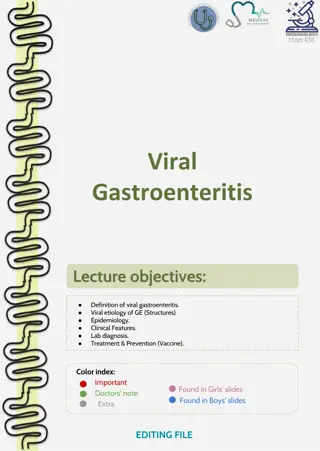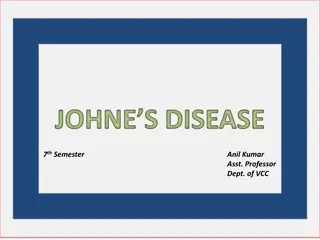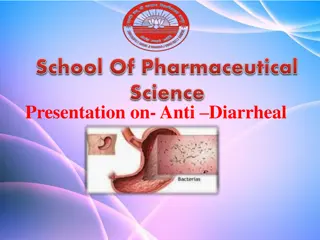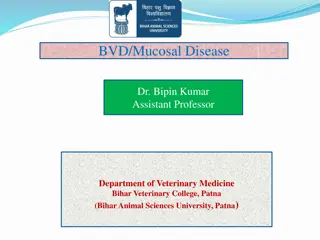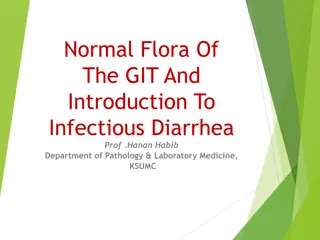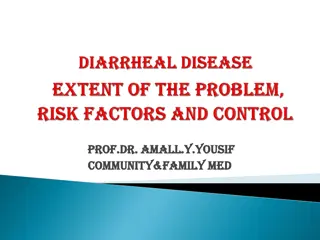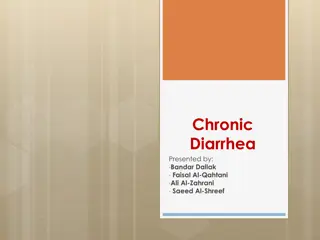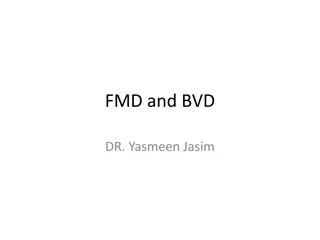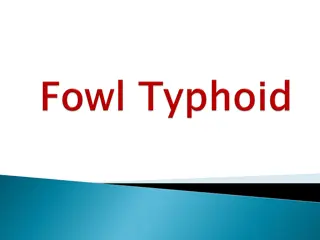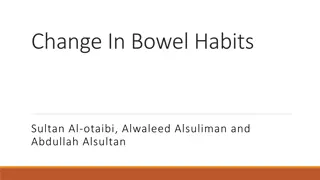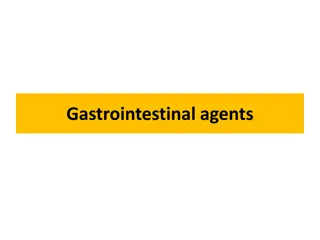Diarrhea: Causes, Classification, and Significance
This informative content delves into the physiology of fluid in the small intestine, defines diarrhea, and outlines its various types and common causes. It emphasizes the importance of addressing diarrhea promptly to prevent dehydration and electrolyte imbalances, especially in children, as it remains a leading cause of global child mortality. The content also categorizes diarrhea based on its pathophysiology and duration, providing a comprehensive overview for better understanding and management.
Download Presentation

Please find below an Image/Link to download the presentation.
The content on the website is provided AS IS for your information and personal use only. It may not be sold, licensed, or shared on other websites without obtaining consent from the author. Download presentation by click this link. If you encounter any issues during the download, it is possible that the publisher has removed the file from their server.
E N D
Presentation Transcript
8 LECTURES Gastro-esophageal reflux disease Peptic Ulcer Disease Diarrhea Malabsorption Inflammatory bowel disease-1 Inflammatory bowel disease-2 Colonic polyps and carcinoma-1 Colonic polyps and carcinoma-2
8 LECTURES Diarrhea Malabsorption
Objectives Upon completion of this lecture the students should : 1. Understand the physiology of fluid in small intestine 2. Describe the pathophysiology and causes of various types of diarrhea ( Secretory, osmotic, Exudative, Motility-related ) 3. Define acute diarrhea and enumerate its common causes 4. Define chronic diarrhea and enumerate its common causes
DIARREAHA DEFINITION World Health Organization 3 or more loose or liquid stools per day Abnormally high fluid content of stool > 200-300 gm/day
Fecal osmolarity As stool leaves the colon, fecal osmolality is equal to the serum osmolality i.e. 290 mosm/kg. Under normal circumstances, the major osmoles are Na+, K+, Cl , and HCO3 .
CLASSIFICATION 1.Acute .if 2 weeks, 2.Persistent . if 2 to 4 weeks, 3.Chronic ..if 4 weeks in duration.
Why important? The loss of fluids through diarrhea can cause dehydration and electrolyte imbalances Easy to treat but if untreated, may lead to death especially in children
Why important? More than 70 % of almost 11 million child deaths every year are attributable to 6 causes: 1. Diarrhea 2. Malaria 3. neonatal infection 4. Pneumonia 5. preterm delivery 6. lack of oxygen at birth. UNICEF
Pathophysiology Categories of diarrhea 1. Secretory 2. Osmotic 3. Exudative (inflammatory ) 4. Motility-related
Secretory There is an increase in the active secretion High stool output Lack of response to fasting Normal stool osmotic gap < 100 mOsm/kg The most common cause of this type of diarrhea is a bacterial toxin ( E. coli , cholera) that stimulates the secretion of anions. Also seen in Endocrine tumours
Osmotic Excess amount of poorly absorbed substances that exert osmotic effect water is drawn into the bowels diarrhea Stool output is usually not massive Fasting improve the condition Stool osmotic gap is high, > 125 mOsm/kg Can be the result of 1. Malabsorption in which the nutrients are left in the lumen to pull in water e.g. lactose intolerance 2. osmotic laxatives.
Exudative (inflammatory ) Results from the outpouring of blood protein, or mucus from an inflamed or ulcerated mucosa Presence of blood and pus in the stool. Persists on fasting Occurs with inflammatory bowel diseases, and invasive infections.
Motility-related Caused by the rapid movement of food through the intestines (hypermotility). Irritable bowel syndrome (IBS) a motor disorder that causes abdominal pain and altered bowel habits with diarrhea predominating Other causes: 1. Diabetic diarrhoea 2. hyperthyroid diarrhoea
Pathophysiology Categories of diarrhea 1. Secretory 2. Osmotic 3. Exudative (inflammatory ) 4. Motility-related
Aetiology Acute diarrhea? Approximately 80% of acute diarrheas are due to infections (viruses, bacteria, helminths, and protozoa). Viral gastroenteritis (viral infection of the stomach and the small intestine) is the most common cause of acute diarrhea worldwide. Food poisoning Drugs Others Rotavirus the cause of nearly 40% of hospitalizations from diarrhea in children under 5
Antibiotic-Associated Diarrheas Diarrhea occurs in 20% of patients receiving broad-spectrum antibiotics; about 20% of these diarrheas are due to Clostridium difficile
Aetiology Chronic diarrhea? 1. Infection ------------------ e.g.Giardia lamblia . AIDS often have chronic infections of their intestines that cause diarrhea. 2. Post-infectious. Following acute viral, bacterial or parasitic infections 3. Malabsorption 4. Inflammatory bowel disease (IBD) 5. Endocrine diseases. 6. Colon cancer 7. Irritable bowel syndrome.
Complications 1. Fluids Dehydration 2. Electrolytes .. Electrolytes imbalance 3. Sodium bicarbonate . Metabolic acidosis 4. If persistent Malnutrition
Tests useful in the evaluation of diarrhea Acute diarrhea Fecal leukocytes present not present Inflammatory Diarrhea Noninflammatory Diarrhea Suggests a small bowel source Or colon but without mucosal injury Suggests colonic mucosa damage caused by invasion shigellosis, salmonellosis, Campylobacter or Yersinia infection, amebiasis) toxin (C difficile, E coli O157:H7). Inflammatory bowel diseases
Chronic diarrhea Infection + Stool analysis Ova, parasites - Secretory or Noninfectious inflammatory diarrhea Stool fat test (normal <20%) - + Malabsorption
Understand the physiology of fluid in small intestine Understand the physiology of fluid in small intestine 1.5 liter food 7 liters secretions and reabsorbed in small intestine 1.4 reabsorbed in large intestine Describe the Describe the pathophysiology pathophysiology and causes of various types of diarrhea and causes of various types of diarrhea Secretory Secretory Normal stool osmotic gap {bacterial toxin ( E. coli , cholera) Endocrine tumours} osmotic, osmotic, osmotic gap is high , {Malabsorption, osmotic laxatives} Exudative Exudative, , blood and pus in the stool, { inflammatory bowel diseases, and invasive infections} Motility Motility- -related { related {Irritable bowel syndrome (IBS)} Define acute diarrhea and enumerate its common causes Define acute diarrhea and enumerate its common causes Less than 2 weeks infections (viruses, bacteria, helminths, and protozoa). Food poisoning More than one month Infection, post Infection Infection, post Infection malabsorption Define chronic diarrhea and enumerate its common causes Define chronic diarrhea and enumerate its common causes malabsorption, Inflammatory bowel disease (IBD), cancer , Inflammatory bowel disease (IBD), cancer
8 LECTURES Diarrhea Malabsorption
Objectives Upon completion of this lecture the students will : 1. Understand that the malabsorption is caused by either abnormal digestion or small intestinal mucosa 2. Know that malabsorption can affect many organ systems ( alimentary tract, hematopoietic system, musculoskeletal system, endocrine system, epidermis, nervous system) 3. Concentrate on celiac disease and lactose intolerance as two examples of malabsoption syndrome.
Malabsorption Syndrome Inability of the intestine to absorb nutrients adequately into the bloodstream. Impairment can be of single or multiple nutrients depending on the abnormality.
Physiology The main purpose of the gastrointestinal tract is to digests and absorbs nutrients (fat, carbohydrate, and protein), micronutrients (vitamins and trace minerals), water, and electrolytes.
Mechanisms and Causes of Malabsorption Syndrome Inadequate digestion Postgastrectomy Deficiency of pancreatic lipase Chronic pancreatitis Cystic fibrosis Pancreatic resection Zollinger-Ellison syndrome Deficient bile salt Obstructive jaundice Bacterial overgrowth Stasis in blind loops, diverticula Fistulas Hypomotility states (diabetes) Terminal ileal resection Crohns' disease Precipitation of bile salts (neomycin) Primary mucosal abnormalities Celiac disease Tropical sprue Whipple's disease Amyloidosis Radiation enteritis Abetalipoproteinemia Giardiasis Inadequate small intestine Intestinal resection Crohn's disease Mesenteric vascular disease with infarction Jejunoileal bypass Lymphatic obstruction Intestinal lymphangiectasia Malignant lymphoma Macroglobulinemia
Pathophysiology Inadequate digestion Small intestine abnormalities Or Malabsorption =
Pathophysiology Inadequate digestion Stomach Postgastrectomy Pancrease Deficiency of pancreatic lipase Chronic pancreatitis Cystic fibrosis Pancreatic resection Bile Small intestine abnormalities Obstructive jaundice Terminal ileal resection mucosa Inadequate small intestine Lymphatic obstruction
Pathophysiology Inadequate digestion Stomach Pancrease Bile Celiac disease Tropical sprue Whipple's disease Giardiasis Small intestine abnormalities mucosa Intestinal resection Crohn's disease Inadequate small intestine Lymphatic obstruction Intestinal lymphangiectasia Malignant lymphoma
Pathophysiology Pancrease Bile mucosa
Malabsorption Syndrome Clinical features There is increased fecal excretion of fat (steatorrhea) and the systemic effects of deficiency of vitamins, minerals, protein and carbohydrates. Steatorrhea is passage of soft, yellowish, greasy stools containing an increased amount of fat. Growth retardation, failure to thrive in children Weight loss despite increased oral intake of nutrients.
Malabsorption Syndrome Clinical features Depend on the deficient nutrient Musle wasting, Swelling or oedema Protein Anaemias(fatigue and weakness) B12, folic acid and iron deficiency Osteomalacia and osteoporosis vitamin D, calcium Muscle cramp vitamin K and other coagulation factor Bleeding tendencies
Diagnosis There is no specific test for malabsorption. Investigation is guided by symptoms and signs. 1. Fecal fat study to diagnose steatorrhoea 2. Blood tests 3. Stool studies Biopsy of small bowel 4. Endoscopy
Malabsorption Syndrome Celiac disease An immune reaction to gliadin fraction of the wheat protein gluten Usually diagnosed in childhood mid adult. Patients have raised antibodies to gluten Highly specific association with class II HLA (DQ2 or DQ8) and, to a lesser extent, DQ8 (haplotype DR-4).
Clinical features Celiac disease Typical presentation GI symptoms that characteristically appear at age 9-24 months. Symptoms begin at various times after the introduction of foods that contain gluten. A relationship between the age of onset and the type of presentation; Infants and toddlers .GI symptoms and failure to thrive Childhood minor GI symptoms, inadequate rate of weight gain, Young adults anemia is the most common form of presentation. Adults and elderly ...GI symptoms are more prevalent
Endoscopy Normal Celiac disease
Celiac Disease Normal Histology Mucosa is flattened with marked villous atrophy. Crypt hyperplasia Increased intraepithelial lymphocytosis
Celiac Disease Diagnosis Clinical documentations of malabsorption. Stool . Fat Serologic tests for celiac disease (namely the anti-TTG-IgA) Small intestine biopsy demonstrate villous atrophy. Improvement of symptom and mucosal histology on gluten withdrawal from diet. wheat, barley, rye Other grains, such as rice and corn flour, do not have such an effect. rye
Celiac Disease Complications Osteopenia , osteoporosis Infertility in women Short stature, delayed puberty, anemia, Malignancies,[ intestinal T-cell lymphoma] 10 to 15% risk of developing GI lymphoma.
Lactose Intolerance Pathophysiology lactase Lactose glucose + galactose At the brush border of enterocytes Lactose Intolerance Low or absent activity of the enzyme lactase
Lactose Intolerance causes Inherited lactase deficiency Congenital lactase deficiency Childhood-onset and adult-onset lactase deficiency extremely rare common Genetically programmed progressive loss of the activity of the small intestinal enzyme lactase. Gastroenteritis: Infectious diarrhea, particularly viral gastroenteritis in younger children, may damage the intestinal mucosa enough to reduce the quantity of the lactase enzyme. Acquired lactase deficiency Transient Secondary lactase deficiency due to intestinal mucosal injury by an infectious, allergic, or inflammatory process
Clinical Bloating, abdominal discomfort, and flatulence 1 hour to a few hours after ingestion of milk products
Lactose Intolerance Diagnosis Empirical treatment with a lactose-free diet, which results in resolution of symptoms; Hydrogen breath test
Hydrogen breath test . An oral dose of lactose is administered The sole source of H2 is bacterial fermentation; Unabsorbed lactose makes its way to colonic bacteria, resulting in excess breath H2. Increased exhaled H2 after lactose ingestion suggests lactose malabsorption.
A 3-week trial of a diet that is free of milk and milk products is a satisfactory trial to diagnose lactose intolerance
